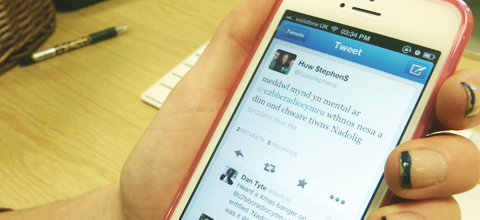The Welsh language is the oldest language in the British Isles, so how is it adapting to the new digital landscape?
A recent Daily Mail article compared the behaviour of Welsh language non-violent activist group Cymdeithas yr Iaith to that of the Taliban. This article sparked outrage amongst Welsh and English speakers alike, and as a result the ‘hashtag’ #welshtaliban appeared on social media site Twitter. A spoof Twitter account, called Welsh Taliban, was also created, contributing much needed humour to the debate. Its first tweet read, “Outed by Daily Mail’s Roger Lewis, PR man suggested we open Twitter account to defend allegations and spread the word #welshtaliban”.
The Welsh language is the most ancient in Britain. It has been spoken for over 1400 years, and is evolving all the time. In contrast, the practice of hash-tagging on Twitter began in 2006, when the microblogging site was born, set free to change the landscape of the digital world as we knew it.
Statistics presented by the Welsh Language Board as a new millennium dawned told us that the number of people speaking Welsh on a daily basis was decreasing. The 2011 census figures, revealed this week, show a further decline.
As with any struggle, the key to keeping the Welsh language alive, fresh and relevant is a continuous challenge; does the answer lie within digital content, new technology and web 2.0? The Welsh language is by no imaginable means a dying language, with 562,000 Welsh speakers in Wales according to the recent census, but does the power to revitalize lie in the digital sphere?
Huw Marshall, digital manager at S4C (the Welsh language television channel), stresses the importance of championing the language digitally, “Social media has become a way of creating a new Welsh community online, one which has a bigger reach than ever before. With respected people such as Alex Jones and Huw Stephens tweeting in Welsh, it normalizes the language, showing people that it is used day to day.”
A shift in perceptions
Digital technology and the web have enormous power to change perceptions and the way we interact with each other. With the birth of Twitter as a social platform people are redefining freedom of speech.
This shift in perceived barriers could benefit the Welsh language, and is a topic for discussion in the next Welsh language digital unconference, Hacio’r Iaith, taking place in January. This fourth yearly unconference, where attendees create the content of the day, will look at the way in which technology relates to the Welsh language, and how the language itself is adapting to digital platforms.
Welsh language software
The Welsh language has already made dramatic strides across the digital landscape. Microsoft delivers a language package that enables people to use their computer’s interface through the medium of Welsh. Google has produced an app which will translate a (spoken) English sentence into Welsh, and then pronounce it back to you via the phone’s speakers. Twitter is also currently working to develop its Welsh language interface, whilst many Facebook users have been navigating the platform through the medium of Welsh for many years. Canolfan Bedwyr, a study centre based in Bangor University, is making exciting advancements in Welsh language technology for visually impaired people.
However, technology in a minority language may require a particular commitment, especially if colleagues and friends are using the mainstream English-language version. As Dr Jeremy Evas, lecturer at Cardiff University and previously an advisor for Microsoft’s Welsh language technology, points out,
“The difficulty at the moment is that this software isn’t automatically offered to people. It should be offered readily, without reluctance.”
Welsh identity online
Developments within the digital landscape have not only been within large digital companies. Original Welsh platforms have also been created, such as comical website Y Rhegiadur, listing Welsh swear words in alphabetical order, complete with explanations. Its creator is web-expert Rhodri Ap Dyfrig, who is currently researching the use of minority languages online. There are also numerous Welsh-language blogs, naturally, on topics ranging from serious political debate to music.
Yet the number of people who practise Welsh in the digital sphere are in the minority. Evas explains, “It depends on how confident you are with your own identity as a Welsh speaker. People have a very fixed idea of what should be in Welsh, and what shouldn’t be in Welsh, but Facebook and Twitter as platforms are certainly working to dispel these notions.”
The government will be announcing their digital strategy for the Welsh language in the New Year, with focus on promoting daily use of the language. Advances in Welsh language software, and the use of the language on all social platforms, will not by themselves keep the language alive. However, these growing developments in brand new mediums can spark debate, challenge cultural identities, create new communities and many more hashtags for discussion. This can be fuel for the continuation of any language and its culture.

